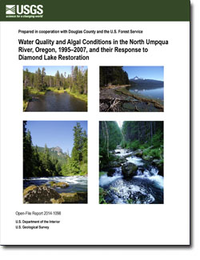Water quality and algal conditions in the North Umpqua River, Oregon, 1995-2007, and their response to Diamond Lake restoration
Links
- More information: USGS Index Page
- Document: Report (6.6 MB pdf)
- Appendix: Appendix (6.9 MB xlsx)
- Download citation as: RIS | Dublin Core
Abstract
The Wild and Scenic North Umpqua River is one of the highest-quality waters in the State of Oregon, supporting runs of wild salmon, steelhead, and trout. For many years, blooms of potentially toxic blue-green algae in Diamond and Lemolo Lakes have threatened water quality, fisheries, and public health. The blooms consist primarily of Anabaena, a nitrogen (N)-fixing planktonic alga that appears to have contributed to N enrichment, which could account for changes in communities and biomass of periphyton, or attached benthic algae, in the river. Periphyton can become a nuisance in summer by affecting riffle habitat and causing high pH that fails to meet State of Oregon water-quality standards. These symptoms of nutrient enrichment in the North Umpqua River were first documented in 1995, and the symptoms have continued since then. Restoring natural ecosystem processes that store nutrients rather than fueling algae might help improve pH and water-clarity conditions.
This report summarizes the results from a study in 2005–07 characterizing water quality and algal conditions in the North Umpqua River before, during, and after the 2006 rotenone treatment of Diamond Lake in the headwaters of the North Umpqua River. The treatment was part of a restoration project to eradicate Tui chub (Gila bicolor), a non-native invasive fish blamed for decimating the trout fishery in Diamond Lake and fueling Anabaena blooms. Diamond Lake was expected to contribute organic matter and associated nutrients to Lake Creek during the project, but it was unclear whether these nutrients would affect periphyton communities in the North Umpqua River downstream.
This study also provided an opportunity to examine changes in stream conditions in the main stem North Umpqua River and its tributaries, which were previously sampled in July 1995. The 1995 study was designed to provide background data during relicensing of the upstream hydroelectric facilities, and was partly motivated by anecdotal concerns about increase periphyton growth and reduced water clarity. As part of the 2005–07 study associated with the Diamond Lake restoration project, we repeated the 1995 basinwide synoptic survey in 2005, before the rotenone treatment. Although both samplings were just a snapshot of conditions, these data were evaluated for possible changes between 1995 and 2005.
Study Area
| Publication type | Report |
|---|---|
| Publication Subtype | USGS Numbered Series |
| Title | Water quality and algal conditions in the North Umpqua River, Oregon, 1995-2007, and their response to Diamond Lake restoration |
| Series title | Open-File Report |
| Series number | 2014-1098 |
| DOI | 10.3133/ofr20141098 |
| Year Published | 2014 |
| Language | English |
| Publisher | U.S. Geological Survey |
| Publisher location | Reston, VA |
| Contributing office(s) | Oregon Water Science Center |
| Description | Report: viii, 89 p.; Appendix |
| Time Range Start | 1995-01-01 |
| Time Range End | 2007-12-31 |
| Country | United States |
| State | Oregon |
| Other Geospatial | Umpqua River |
| Datum | North American Datum of 1983 |
| Projection | Universal Transverse Mercator projection |
| Scale | 24000 |
| Online Only (Y/N) | Y |
| Additional Online Files (Y/N) | N |


